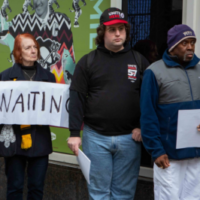Kate is a pilot and former employee of the cargo airline Ameriflight. Eager to advance her career in the face of the difficult job market created by the COVID-19 pandemic, Kate took a job with Ameriflight even though the company imposed a two-year commitment for providing a routine training required of all airlines by the Federal Aviation Administration. In the face of low pay and safety concerns, Kate ultimately decided to pursue a better opportunity with another airline before her employment term was up.
After she left, the company responded by informing her that she owed them tens of thousands of dollars for her mandatory training.
This is because she had signed a Training Repayment Agreement Provision, or a TRAP, which requires departing workers to reimburse their employer for any on-the-job training. These are a type of stay-or-pay contract, in which a departing worker has to pay a penalty for leaving their job. TRAPs and other types of stay-or-pay contracts are often forced on workers as a condition of employment, allowing corporations to use the threat of debt collection or litigation to lock workers in place, limiting their mobility and bargaining power, and leveraging crushing financial penalties when a worker does dare to leave.
The use of TRAPs has exploded among workers in high-demand sectors like computer programming, entry-level finance, health care, retail and hospitality, and transportation. Earlier this year, academics released new findings about the prevalence of TRAPs, uncovering a rise in survey respondents indicating they have worked under a TRAP, from 4.1 percent in 2014 to 8.7 percent in 2020. The Student Borrower Protection Center estimates that major employers rely upon TRAPs in segments of the U.S. labor market that collectively employ more than one in three private-sector workers. A 2022 survey conducted by National Nurses United reported that almost 45 percent of responding new nurses with between one and five years of experience were bound by TRAPs, often with repayment amounts exceeding $10,000.
The growing use of stay-or-pay contracts has caught the attention of federal regulators. The National Labor Relations Board (NLRB) General Counsel has issued guidance to all of its regions that most non-competes and TRAPs are unfair labor practices under the National Labor Relations Act, and has reached settlements with companies to release workers from them. And earlier this year, the Federal Trade Commission (FTC) released one of the most significant regulations of the Biden Administration: a comprehensive ban in the industries that it regulates on traditional and de facto non-compete clauses, including TRAPs.
But more action is needed to protect workers from the growing use of stay-or-pay contracts, particularly at the state and city levels. While the FTC’s rule provides a clear line for protecting workers from these contracts, many of the industries that have most notably abused TRAPs fall outside of their jurisdiction, such as aviation and trucking. And already, corporate interests have sued and a federal court in Texas has temporarily blocked this rule before it could even take effect. City and state regulators have an opportunity to investigate the use of TRAPs through the prism of existing state and city laws, even when there is not an explicit prohibition on TRAPs, as existing local consumer protection, unfair competition, antitrust, or wage and hour laws may make most TRAPs illegal.
That is why over the coming weeks, we will be releasing a deep dive series into how city, county, and state regulators can take on TRAPs using existing authorities to protect workers. We are also releasing a legislative toolkit for lawmakers interested in introducing new legislation that would ban TRAPs. Lawmakers and regulators at all levels have the ability to stop worker debt traps, and can deliver on the promise to ban TRAPs, regardless of the outcome of partisan court challenges. Finally, we will also highlight this series at an upcoming virtual event featuring series authors and local government regulators on how they’re already beginning to pursue these cases.
If left unchecked, TRAPs and other stay-or-pay contracts have the potential to leave workers buried in debt just for taking a better opportunity or for having to quit a job to navigate personal hardship such as a family health crisis or a childcare shortage. Lawmakers and regulators at all levels should build on the early actions of the FTC and NLRB, and mobilize to protect workers and honest businesses by driving the use of TRAPs and other stay-or-pay contracts out of the economy.
Paul Sonn is NELP’s state policy program director.
Chris Hicks is a Senior Policy Advisor at the Student Borrower Protection Center, and focuses on the intersection of consumer and labor protections.





